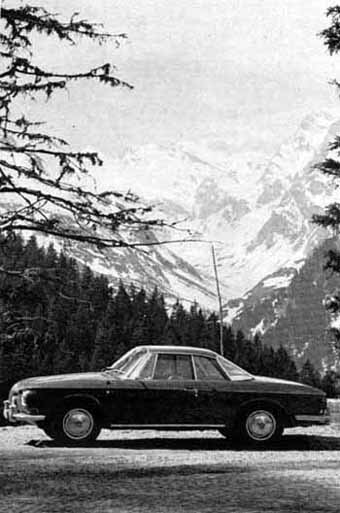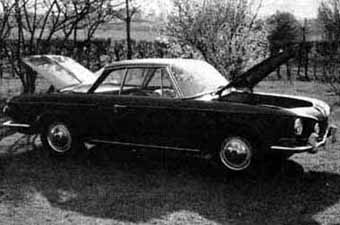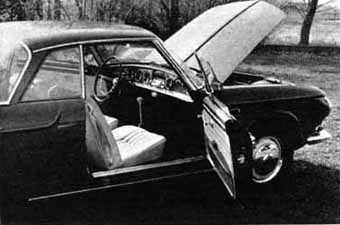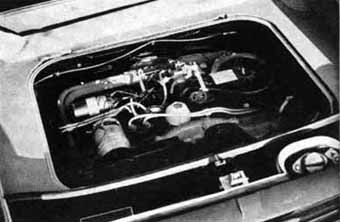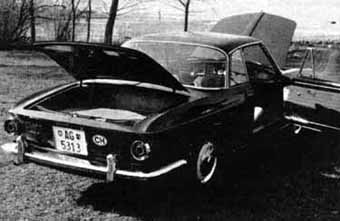February 1963 edition of Road & Track - The Motor Enthusiasts' Magazine
Scanned images of the following magazine article were thoughtfully supplied by Paul Colbert and the VW Type 34 Registry.
|
A well adjusted compromise between luxury and economy in a touring car
STORY AND PHOTOS BY HANSJÖRG
BENDEL |
 WHEN THE prototype Karmann-Ghia, built on the chassis of the
1200-cc "beetle," was prepared for the Frankfurt Motor Show in
1955, not many people would have accepted bets on the
commercial success of this new venture. After all, the basic VW
has not got such an abundance of power that it just asks for a
stylish coupe body, and Karmann never made any attempt at
tuning its K-G into a 'less expensive Porsche.' Also, it was
immediately apparent that the attractive selling price of the
sedan would have to be exceeded substantially due to smaller
production volume as well as because of refined finish. But the
customers queued up: just as in the case of the standard model,
the K-G confounded its critics by selling by the thousands, and
continues to be made, very little changed at the rate of about
60 per day.
WHEN THE prototype Karmann-Ghia, built on the chassis of the
1200-cc "beetle," was prepared for the Frankfurt Motor Show in
1955, not many people would have accepted bets on the
commercial success of this new venture. After all, the basic VW
has not got such an abundance of power that it just asks for a
stylish coupe body, and Karmann never made any attempt at
tuning its K-G into a 'less expensive Porsche.' Also, it was
immediately apparent that the attractive selling price of the
sedan would have to be exceeded substantially due to smaller
production volume as well as because of refined finish. But the
customers queued up: just as in the case of the standard model,
the K-G confounded its critics by selling by the thousands, and
continues to be made, very little changed at the rate of about
60 per day.In view of this success, it is hardly surprising that when the VW-l500 became a reality. Wolfsburg and the Karmann works teamed up once more. When the 1500 sedan was unveiled at Frankfurt in the autumn of 1961, new Karmann Ghia models were ready as well, and in the spring of 1962 the coupe assembly lines were in full operation. Very soon, the convertible sedan 1500 (already shown as a prototype in Frankfurt) will be in production. Following the practice established with the well-known forerunner, the little-changed platform type chassis of the sedan is combined with a special two door coupe body, Haute Couture by Ghia of Turin, with lower build, improved aerodynamics and, of course, reduced room for occupants and luggage. |
On the roads of Europe, K-G 1500 coupes are
already familiar, so once again buyers are prepared to pay
extra money for a smaller car, just because it is
different. What are they getting for their marks, francs or lire? The first point to discuss might be the question of beauty. Some people like the newcomer very much, whereas others have not a single kind word for it - the rear end is accepted by most, but the front end with its distinctive cat's whiskers framing a narrow-gauge pair of fog lamps has been the object of much controversy. One thing seems certain. Beautiful or not, giving the car the "different look" was a compulsory design target which - not many will doubt this - was accomplished. Because running gear and engine are identical on K-G and sedan, no sensational differences can be expected when driving the coupe, and we rediscovered most of the characteristics already commented upon in the test report of the standard car (R&T. May 1962), which therefore need no recapitulation. The later models which left the assembly lines since August 1962 benefit from improved manufacturing methods and incorporate some detail improvements. On the mechanical side, there are larger intake valves, improved cooling air ducting for the engine and wider brake shoes on the chassis. The body, too, has been generally cleaned up. We drove the original version first, then checked our findings on a late model, which eliminated some points of criticism. |
|
One of the first impressions one gains is that of very nice handling. Just as its more mundane sister, the K-G is fun to drive, highly maneuverable, and always manages to convey an impression of agility and speed superior to the cold figures of the stop watch& in other words, a decidedly sporting character and a constant invitation to enjoy one's daily mileage. Broadly speaking, road holding is the same as that of the sedan, with the notable exception of much reduced sensitivity to side winds. Whatever the reason, this is an improvement, which is as welcome as it is necessary. Performance is slightly better, particularly at the upper end of the speed range, and certainly satisfactory for the kind of use to he expected from the average owner. The car's effortless running on highways is particularly pleasant and remains an example which several other, more powerful, cars might do well to follow. After descending an Alpine pass in our first test car (which had the original brakes) there was an unmistakable hot smell and brake squeal; but fading was slight, and normal performance and perfect balance were restored quickly. Bearing in mind that this model is definitely not planned for rallies, the larger brake lining surface since introduced should prove ample. Before setting out now to discuss controls and interior furnishings (where the K-G is of course markedly different from the sedan) we have to qualify: The K-G costs substantially more than the standard sedan and must be looked at as a luxury version. Therefore, it undoubtedly has to be judged by a more exacting yardstick. This explains why we have to lay our finger on some shortcomings which might be perfectly tolerable on the cheaper sedan (some of them are peculiar to the K-G, though) but have no place on a model of higher ambitions. The first look indoors always goes to the instruments. For styling reasons, the speedometer has been made smaller
|
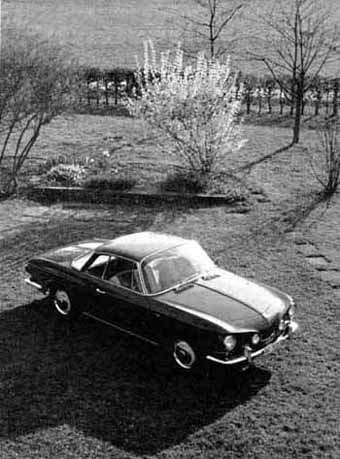
than its counterpart on the sedan, and has
not been completed by the very useful trip mileage counter
familiar on many less expensive cars. For legibility at
speed, a full-size instrument would be preferable. The front
seats are comfortable and give good support; regrettably, the
stylish roofline has dictated such a low seat level that the
feel of complete mastery over the car and of perfect
visibility is lost. Legroom is generous for all but the most
pronounced stretched-arms drivers. On the first cars tried,
the rake of the seat backs could not be adjusted with
adequate finesse - on the second car we were pleased to find
accessible hand wheels in front of the seats, which would
have been absolutely perfect if they had required a little
less force to turn them. |
 KARMANN-GHIA VW 1500 Porsches, these problems can be partly overcome by the installation of a special gasoline-type heater, which is an expensive and space-wasting solution. Corvair experience, however, seems to confirm that this difficulty is not easy to overcome with an air-cooled engine living at the rear of the passenger compartment. There are two sun visors, nicely padded, which conform to the concave shape of the roof. Folded down for use, they still permit a gap of half an inch between roofline and upper edge of sunblinds, so that a low sun spotlights straight into the driver's eyes. Karmann development engineers must have worn very dark sunglasses never to have noticed this fault. Noise insulation between engine and passenger compartment is improved and, in contrast to some reports we have seen, we have found the wind noise tolerable-4hough we don't deny that at higher speeds, a lower general noise level would make conversation easier still. Finally, a few words on details, which are of some importance on a "personalized" car like this. The armrest on the driver's door as in the way when working the steering wheel in a succession of corners: control of the excellent gearbox (on both cars) is less perfect than on the sedan, with a feel of more flexibility in the linkage; the windshield wiper is very good, fast enough for heavy rain, but noisy on a drying windshield.
|
The front wheel arches intrude too much into
the front compartm ent; this is permissible in the sedan, and
seasoned VW drivers are accustomed to brace their left f oot
against it, but we still feel that on a car of higher price
level, this design feature comes in for criticism. Heel-and-toe
gear change is not easy due to the pedal arrangement, though
this is a dmittedly not essential, due to the good synchromesh:
ground clearance is generous even for rough g oing; initial
pick-up from slow speeds is even more jerky than on the sedan.
Obviously, the ultra low carburetor-cum-manifold arrangement
enforced by the rear luggage compartment has posed carbureti on
and linkage problems, which have not been entirely overcome.
The rear-view mirror has no anti-da zzle position; the panic
bar for the front passenger, very elegantly shaped and
practical on the or iginal product, has been changed for the
worse. We are pleased to record that test car number 2, undoubtedly typical of what customers are getting, displayed a high quality level. Its outside finish was perfect, there were no rattles, and the general feel of bank-safe rigidity was what we have come to expect from Karmann as well as from VW. Final criticism: the color combinations of the plastic upholstery seemed garish and tasteless, As the actual material for seats, door trimmings and roof lining appears to be of good quality, carefully fitted, some extra effort in color composition would be well applied. Summing up: for driving, this is a satisfying car in most respects, with some imperfections which could so easily be eliminated that their presence is all the more surprising. The style is distinctive, the price buys good quality and the privilege of being different-he who likes this combination will probably become a pleased owner, with the added, comfortable knowledge that this very model is likely to remain in production, unchanged, for many years to come.
|
